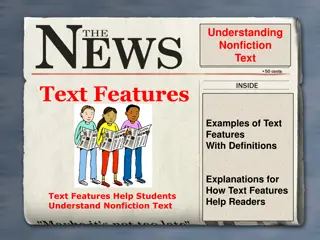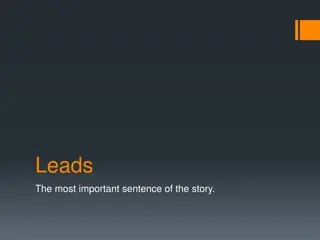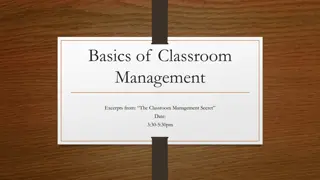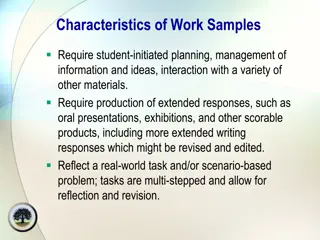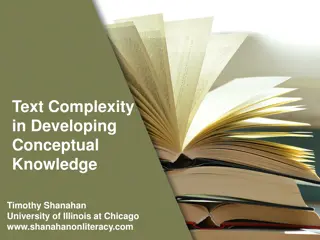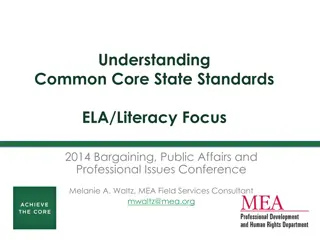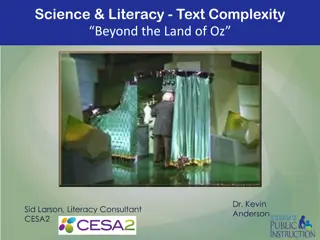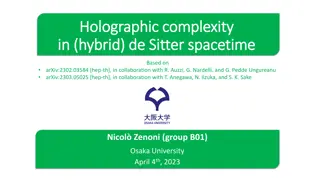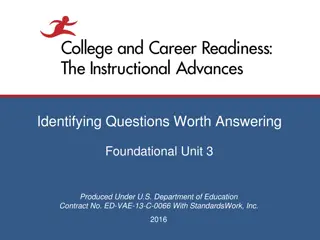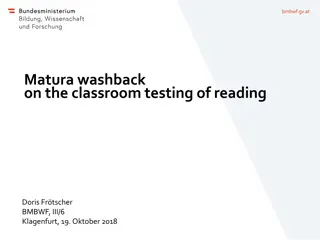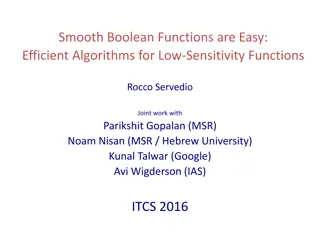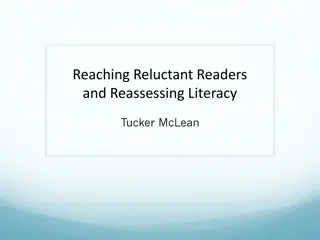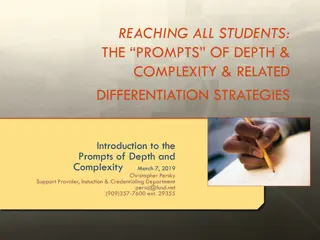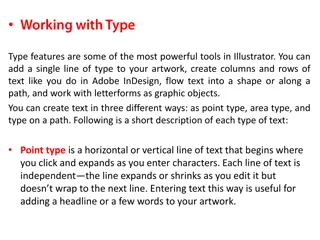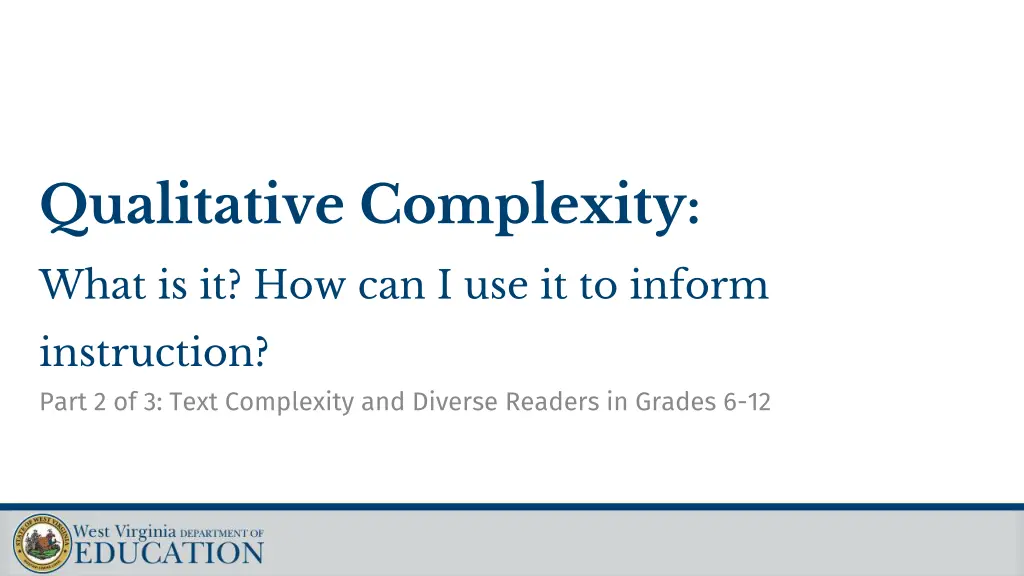
Understanding Qualitative Complexity in Texts for Grades 6-12
Explore how qualitative complexity in texts can inform instructional decision-making for diverse readers in grades 6-12. Learn about the interplay between quantitative and qualitative measures, reader considerations, and task factors. Gain insights into analyzing authors' purpose, central ideas, levels of meaning, craft, structure, figurative language, and more. Enhance your understanding to tailor instruction effectively.
Download Presentation

Please find below an Image/Link to download the presentation.
The content on the website is provided AS IS for your information and personal use only. It may not be sold, licensed, or shared on other websites without obtaining consent from the author. If you encounter any issues during the download, it is possible that the publisher has removed the file from their server.
You are allowed to download the files provided on this website for personal or commercial use, subject to the condition that they are used lawfully. All files are the property of their respective owners.
The content on the website is provided AS IS for your information and personal use only. It may not be sold, licensed, or shared on other websites without obtaining consent from the author.
E N D
Presentation Transcript
Qualitative Complexity: What is it? How can I use it to inform instruction? Part 2 of 3: Text Complexity and Diverse Readers in Grades 6-12
Part Two Learning Part Two Learning Goals Goals Gain a clearer understanding of qualitative complexity as it relates to texts. Gain a clearer understanding of how qualitative complexity informs instructional decision-making. 2
Revi ew: Revi ew: Text Text Co m p l exi ty Co m p l exi ty Quantitative Measure Qualitative Features Reader and Task Considerations Qualitative Features 3
Review: Review: Quantitative Quantitative Measure Measure (Lexile) = (Lexile) = Sentence Length Word Length Unknown Words
Qual i tati ve Co m p l exi ty = Qual i tati ve Co m p l exi ty = Quantitative Measure (Lexile) Author s Purpose Central Idea(s) Layers of Meaning Craft and Structure Figurative Language Language Conventions Knowledge Demands Vocabulary Concepts Context/History Qualitative Features Reader and Task Considerations Qualitative Features 5
Now then, Pooh," said Christopher Robin, "where's your boat?" "I ought to say," explained Pooh as they walked down to the shore of the island, "that it isn't just an ordinary sort of boat. Sometimes it's a Boat, and sometimes it's more of an Accident. It all depends." "Depends on what?" "On whether I'm on the top of it or underneath it. 620L (3rd and 4th grade) 6 Qualitative s
"Sir Winston, if you were my husband, I would poison your tea. "Madame, if you were my wife, I would drink it." Conversation between Lady Astor and Sir Winston Churchill 7 Qualitative s 390L (1st and 2nd grade)
When in the Course of human events, it becomes necessary for one people to dissolve the political bands which have connected them with another, and to assume among the powers of the earth, the separate and equal station to which the Laws of Nature and of Nature's God entitle them, a decent respect to the opinions of mankind requires that they should declare the causes which impel them to the separation. 2030L (Graduate School +) 8 Qualitative s
Critical Consideration for Instructional Critical Consideration for Instructional Design Design: : Consideration #1: How do I know if the text I ve selected is complex? 9
Considering Overall Text Complexity: Considering Overall Text Complexity: The Tell Tale Heart The Tell Tale Heart by Edgar Allan Poe by Edgar Allan Poe Reader Considerations: Prior knowledge Interests or motivation to read Age/Maturity Cultural/Societal Qualitative Features: Layers of Meaning Figurative Language Author s Purpose Craft and Structure Language Conventions Knowledge Demands Lexile: 820 12
Considering Overall Text Complexity: Considering Overall Text Complexity: The Giver by Lois Lowry The Giver by Lois Lowry Qualitative Features: Layers of Meaning Figurative Language Author s Purpose Craft and Structure Language Conventions Knowledge Demands Reader Considerations: Prior knowledge Interests or motivation to read Age/Maturity Cultural/Societal Lexile: 760 13
Task One: Determine the central idea of the passage below and provide a summary distinct from personal opinion. The former render possible theoretical cognition according to principles a priori; the latter in respect of this theoretical cognition only supplies in itself a negative principle (that of mere contrast), but on the other hand it furnishes fundamental propositions which extend the sphere of the determination of the will and are therefore called practical. Passage taken from pg. 1 of Immanuel Kant s Critique of Judgment 14
Task Two: Read the following passage, then write a brief argument either defending or countering Fern s point of view in regard to her father s approach to raising farm animals. Where's Papa going with that ax?" said Fern to her mother as they were setting the table for breakfast. "Out to the hog house," replied Mrs. Arable. "Some pigs were born last night. "I don't see why he needs an ax," continued Fern, who was only eight. "Well," said her mother, "one of the pigs is a runt. It's very small and weak, and it will never amount to anything. So your father has decided to do away with it. "Do away with it?" shrieked Fern. "You mean kill it? Just because it's smaller than the others?" 15
Table Discussion Table Discussion Which task was more challenging? Why?
Table Discussion Table Discussion Would a lesson on finding main idea or summarizing prepare you to more effectively tackle Task 1? Why or why not?
How does this activity shape our thinking How does this activity shape our thinking when designing instruction? when designing instruction?
Key Take-Aways Quantitative measures and qualitative features both factor into the overall complexity of a text. Addressing grade-level standards requires the study of texts that are quantitatively and qualitatively complex. Quantitative measures help us forecast what scaffolds may be necessary to meet our instructional goals with a text. Qualitative features help us align the study of a text to specific grade-level standards. 19
Reader and Task Considerations: What are they? How do they round out text complexity? Part 3 of 3: Text Complexity and Diverse Readers in Grades 6-12 Weekly Teams Chat May 28th, 2020
Part Three Learning Part Three Learning Goals Goals Gain a clearer understanding of reader and task considerations and their role in determining text complexity. Gain a clearer understanding of the relationship between standards-aligned tasks and text complexity. 21
Revi ew: Revi ew: Text Text Co m p l exi ty Co m p l exi ty Quantitative Measure Qualitative Features Reader and Task Considerations Qualitative Features 22
Review: Review: Quantitative Quantitative Measure Measure (Lexile) = (Lexile) = Sentence Length Word Length Unknown Words
Qual i tati ve Co m p l exi ty = Qual i tati ve Co m p l exi ty = Quantitative Measure (Lexile) Author s Purpose Central Idea(s) Layers of Meaning Craft and Structure Figurative Language Language Conventions Knowledge Demands Vocabulary Concepts Context/History Qualitative Features Reader and Task Considerations Qualitative Features 24
Reader and Task Co nsi derati o ns= Reader and Task Co nsi derati o ns= Qualities the reader brings to the text and to the nature of the task being undertaken Attention, short term working memory, critical and analytical skills Reader s skillfulness w/ inferring, predicting, visualizing, etc Engagement, motivation, prior knowledge and experience Maturity and sensitivity Expectation of the task (aka standard(s) being addressed Quantitative Measure (Lexile) Reader and Task Considerations Qualitative Features
Critical Consideration for Instructional Design Critical Consideration for Instructional Design: : Consideration #2: How will I provide students with on-grade level, standards-aligned learning activities and tasks? 26
Reader and Task Considerations: Reader s Lexile Measure Lower than the Text s When the reader s Lexile measure is lower than the measure of the text, the reader will often struggle with the task if left unsupported. Use the Lexile Framework to help identify additional supports students may need with vocabulary and sentence structure. Address complex sentence structures and challenging phrases explicitly as part of an overall study of the text s theme/central idea. Address discipline specific and other challenging vocabulary explicitly and in context to the text. 27
Reader and Task Considerations: Comprehension and Retention Specific learning disabilities as well as social/emotional factors may impede a student s ability to comprehend or retain what they read complicating their ability to complete on-grade level, standards-aligned tasks. Work with counselors and special educators to identify student needs Utilize chunking, note-taking, mnemonics, and other supports Be mindful of social/emotional factors when selecting texts and topics of study 28
Considering Overall Text Complexity: Considering Overall Text Complexity: The Tell Tale Heart The Tell Tale Heart by Edgar Allan Poe by Edgar Allan Poe Qualitative Features Unreliable narrator Lexile 820L Difficult content like murder and insanity Lexile Range: Grades 3-5 1843 archaic language Suggested for: Grades 6-8 Unconventional sentence structure and punctuation 29
Considering Overall Text Complexity: Considering Overall Text Complexity: The Giver by Lois Lowry The Giver by Lois Lowry Lexile Qualitative Features Narrative contains several flashbacks 760L Lexile Range: Grades 3-5 Difficult content like loss of free will and death of loved ones Suggested for: Grades 7-9 Use of euphemism requires inference making 30
Reader and Task Considerations: Reader s Level of Skillfulness When readers struggle with comprehension skills like inferencing, predicting, and/or visualizing, explicit support is often needed to support them with on-grade level, standards- aligned tasks. Analyze a text s qualitative features to help identify sections where students may struggle: complex ideas, themes, or text organization as well as figurative language and literary techniques. Design sets of standards-based text-dependent questions to scaffold students from part-to-whole, including support TDQs targeting a standard in a lower grade level to give students the step they need to reach the current standard on the focus TDQ. 31
Determining Text Determining Text Complexity Complexity Analyze a classroom text for three aspects of text complexity: Central ideas Structure Vocabulary 34
Sample of Completed Text Complexity Analysis Sample of Completed Text Complexity Analysis 35
Standards Standards- -Aligned Practice: TDQs Aligned Practice: TDQs ELA.7.4 Start Small ELA.7.10 Address Challenging Portions ELA.7.10 Address Central Ideas ELA.7.6 ELA.7.5, ELA.7.6 Analysis 36
Reader and Task Considerations: Reader s Prior Knowledge and Experiences A reader s prior knowledge of a topic can be a barrier or a blessing. Determine how much students already know about the topics, vocabulary, and concepts in the text. Help students with higher levels of knowledge/experience leverage their familiarity to strengthen their comprehension and overcome other areas where they may be weaker. Help students with lower levels of knowledge/experience close their knowledge or experience gaps by addressing vocabulary and content necessary to understand the text explicitly remembering to always bring the learning back into context with the text. 37
Impact of Knowledge Demands on Comprehension 100% 90% The Baseball Study Recht & Leslie (1988) 80% 70% 60% 50% 40% 30% 20% 10% 0% high reading ability & high knowledge low reading ability & high knowledge high reading ability & low knowledge low reading ability & low knowledge
Ensuring All Students Success with On Ensuring All Students Success with On- -Grade Level, Standards Aligned Learning Activities Aligned Learning Activities and Tasks and Tasks Do the questions mirror the language and the skills in the standard itself? Grade Level, Standards- - Is the focus passage(s) appropriate to answer the focus question? Do the scaffolding questions help gather the evidence necessary to answer the focus question? Are there more than 3 or 4 scaffolding questions per focus question? If there are more than four, the size and scope of the focus TDQ/lesson is likely too big and it needs to be reevaluated. 39
Key Take-Aways Quantitative Measures, Qualitative Features, and Reader and Task Considerations all factor into the overall complexity of a text for students. Quantitative measures help us forecast what scaffolds may be necessary to meet our instructional goals with a text. 40
Key Take-Aways Qualitative features help us align the study of a text to specific grade-level standards. Intentionally sequenced learning activities and tasks support student mastery of standards and student perseverance with complex texts. 41
Dr. Andrea N. Lemon Lead Coordinator Office of Middle/Secondary Learning alemon@k12.wv.us 304-558-5325 42

